Gagá

The Dominican-Haitian Gaga, a cult for the here and now
Soraya Aracena
Always on Holy Thursday, the iron rod wedged in the ceremonial fire is lit awaiting the celebration of the Gaga in the the voodoo temples (hounfourd) of the villages where those engaged in the planting, cultivation and production of sugar cane live, as well as the nearby neighborhoods inhabited by Haitians and Dominicans alike, who patronize the "Loas" of the Haitian Petros pantheon strong, aggressive, demanding and severe gods. The Gaga, is a cult where the social, economic, artistic and religious are wisely intermingle, as well s being the most anticipated event of the year because it celebrates resurrection, fertility and sexuality. Part voodoo, part African religion transplanted to Haiti and then to Dominican Republic by Haitian immigrants, Gagá was brought to the Dominican Republic by Haitians who are in the country since 1844, when the Republic was created and later by those Haitians brought into the country to work in occupations related to the production of sugar cane as a result of the many agreements between the Haitian and Dominican government. It was also brought by others who came on their own in search of daily bread and as a result formed Dominican families producing offspring who are now Dominicans as they were born on this side of the island.
"The Petro Loas of the Gagá pantheon allow their servers to be who they are, and demand from their servers or worshippers to let them be what they are, this allows, authorizes and encourages them to return to their house of worship and to define a critical attitude, a revolutionary practice in the darkest and most miserable moments of their lives. These violent, stout, bloodthirsty divinities prevent their believers from sinking hopelessly in the denigrating mud of the slurs, the overpowering ignominious prejudice, hardship, misery and hunger that they face and allow them to await an uncertain future with honor, with attitude of challenge, violent struggle, resistance, persistence, consciousness , cultural identity, pride and awareness of what belongs to them and above all they offer hope and possibilities, with the conviction that through sacrifice, tomorrow may be much better. "
Such Loas are revered not only for their supernatural attributes, which is the recognition of their powers, but also for their role in intervening in human affairs, in the here and now, as it is reflected in the day to day living of the human being, denoting the understanding, kindness, and love of these entities far above their “evil” features and attributes.
The Iron Fire Bar, known in voodoo as Bukan, as it is the place where the god of the same name inhabits, is located a few meters from the rustic wood construction (hounfour) that has a thatch roof made of sable palm fronts, and which, for the occasion its ceiling is decorated with bright colored paper forming a multicolored waterfall and which will accommodate hundreds of worshippers, young and old adults of both sexes that at the begin the evening will arrive in motorcycles, by foot, or in loaded buses carrying sealed packages containing the clothing they will used during the three days of the rigorous pilgrimage that is part of the Gaga and which must not be seen until after the clothing are baptized in a ceremony where Catholicism prayers are sung and where the maximum dimension of Afro-Spanish cultural syncretism is exposed along with the mix of indigenous culture, that accompanies this cult maintained through its transformations. The god who dwells in the Bukan bar is offered grilled root vegetables, in a ceremony headed by Hungan.
These visitors, mostly young and some old Gaga participants, have a mission in this cult, they are part of a complex hierarchy that is acquired after a promise, contracted with the gods, which can be as long as one to seven years and which is sworn-in a complex ceremony of the chair, which may be weeks before Holy Thursday and in some Gagas might take place that evening. For this solemn activity one of the "heads" or knowledgeable of voodoo and its mysteries, places a white sheet in the center of the temple at the so-called "center post" of the temple - the place where it is believed the gods converge.
Here each participant escorted by the owner of Gaga, who is the head of the production and is responsible to fund and to coordinate everything to do with the route the Gaga must make, is seated and raised one by by the members of the group, some with red scarves, green blue and black on their shoulders and other with the scarves strapped to their forearms, as it is believed that it is with a scarf that you tied down the being.
The Gagá staff forms a sort of government, so it has a president, notaries, ministers or deputies, clerks and police, along with remnants of a hierarchy in which the queens occupy an important position, therefore the first elevation of the chair belongs to the president, who is to be responsible for ensuring that all personnel involved in the Gaga participates in the pilgrimage and the president is as well the one who maintains order amongst the worshippers. Then the next to be lifted is the secretary, the director of the pilgrimage and next the Flag bearers of the Dominican flag, followed by those who represent each of the gods and the bearers or symbols that may be alluding to the gods - geometric lines and exquisite works of Haitian voodoo art, and also images taken from popular chromolithographs of Catholic saints.
After that it is the Queens’ turn, there being a first queen who, beginning Holy Thursday through Easter Sunday, becomes the "spiritual partner of the Gagá owner". The owner in most cases is a priest or Hungan as they called the old Haitian voodoo practitioners of the mysteries of the gods, possessed of shrines, visited by people who seek to heal their afflictions. Besides the first queen, the queen of the treasury who is responsible for carrying the treasury box where the public after, seen the group dance, deposits some money into, which, on Easter Sunday, at the conclusion of the celebration, is split between group members.
Part of this complex hierarchy, are the majors, the male dancers who come dressed in a kind of skirt, made from hundreds of colorful scarves that are collected and bought throughout the year and as they dance resembles a rainbow. Some of the majors tie at the ends of the scarves magic powders with titles such as: "sweep-it-all", " tame-the-fierce", "fire-with-him" which they use with the conviction that they have powers to effect and bring good fortune. To complete their wardrove, they cover their heads with baseball caps adorned with fringes, colored ribbons, mirrors or other bright colored accessories.
The majors and the queens are accompanied by the musicians who play various instruments compared by some scholars to musicical instruments used by jazz bands, they play rustic metal trumpets with wide mouth known as "Tatuas" and made by popular craftsmen who are also responsible for the elaboration of the rattle or "Chacha" used to accompany the songs. In this musical band the drums stand out and in particular the "Tambú" a sacred Gaga instrument, built on the trunk of an avocado tree that in covered with goat or cow skin and is painted in bright colors and which must be baptized by its godparents in private ceremony before it can be used .
According to some Gaga musicians the "drums have gunpowder and fire that falls down from the sky; the hides are heated and the gods begin to descend to dance, eat and sing with us, others heal and give good advice to all while the party lasts. "
Other instruments are flutes or bamboos made of the trunk of the bamboo bush from where it gets its name and of which there are very elongated ones and they are composed of four or more and range from high to low, the largest is called "Father bamboo". Alongside these bamboos, there is a small wooden drum known as cataliè. The last instrument, which is also important is the chacha, tin rattle which sets the pace to be followed in the song. To this group of instruments one might include pieces of plastic tubes or hoses that adds a special rhythmic sound to the Gaga.
After the rise of the chair and christening of the clothes and of other objects linked to the cult, the owner of Gaga who, accompanied by a series of "experts" and who, in this case belong to the inner circle of the family, makes a series of acts of magical ritual to all of the members of the Gaga and proceeds to symbolically bathe the Gaga staff who will to start to remove the clothing from the temple to where the activity takes place in the morning.
For this bath, which is prepared in order to protect those who participate in the tour, different plants considered "magical" by voodoo priests are used which were previously sought in the bush for such purposes with their prayers and private ceremony , to this they add a mix of Florida Water perfume, Santa Clara, Jalon, Devil Expeler and hair brilliantine, among others products considered magical by voodoo believers, the mixture of the products is placed in the calves, neck, wrists and forearms of each of the persons involved in the activity as a way of protection.
At dawn on Friday, the owner takes all staff out of the temple walking backwards, covered with a white sheet as if in a shroud, symbolizing being dead and coming back to life after being blessed by the owner.
Once the entire Gaga ritual is finished, headding the procession are the Dominican and loas flags, who accompany them and a man who is part of the cult and who constantly is sweeping away the evil spirits with a broom and he is followed by the other members of the group to begin their tour. Their first visit is to the "KALFU" or crossroads at which the flags will be made to take several bows, because like rivers, streams, thunder or lightning, the crossroads are considered a magical place where Loa or mystery inhabit.
After greeting the inanimate beings, the Gaga continues its course, the queens sensually dancing and visit the homes of people who belong to the in the family of worshipers, voodoo society members and other relatives. At these Tops majors, with their tin batons in hands and others with machetes twirl them with dexterity through their hands delighting observers, after which the queen will pass the treassury box asking for donations.
On Easter Sunday, the majority of Gagás, will return it to their homes, where like heroes are awaited by the public with the food that the women have previously cooked. Again under the temple or Hounfour they sing and dance nonstop, while some gods take possession of some of the dancers to deliver the haversack, which contains in addition to magic potions some beings and the dead that have been previously and symbolically unburied at the cemetery in a secret ceremony that only the owner and some of the closest members of the voodoo society participate in, to accompany the ceremony that at the end is nothing more than the celebration of life over death, regeneration and perpetuation of the human species and the triumph of the most intimate expressions of being and especially the victory of good over evil.
Therefore, it is very unlikely that the Loas, beings or gods will leave or disappear from the cultural scene of the country (Dominican Republic), even with potential material gains, since the Gagá with their infinite army of Loas, is one of the strongest aspirations of man: to communicate with the world of the "invisible" seeking to remedy their ills, meeting their needs and the hope of surviving the here and now.
Alegría Pons, José Francisco: Gagá y Vudù en República Dominicana: Ensayos Antropológicos: Pàg: 21:1993. Ediciones Chango Prieto.
“Majores/Baton major/Majó jon Gaga San Luis

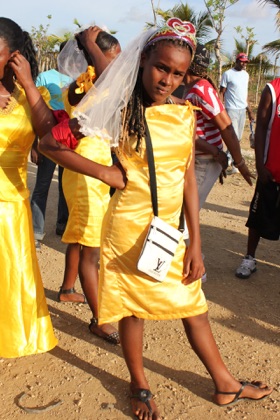
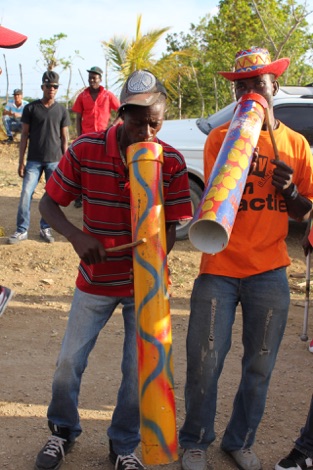
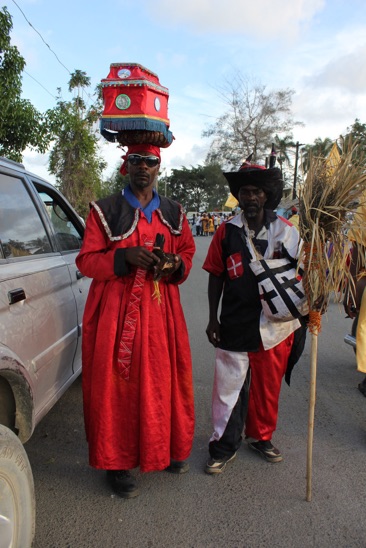
One of the Queens of Gaga San Luis, Dominican Republic
Musicians playing the Bamboo horns of Gaga San Luis, Dominican Republic
Two of the participants of Gaga San Luis, Dominican Republic who carry the “dead” who protects the group.
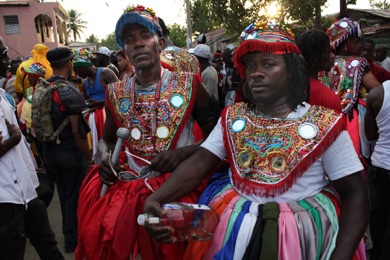
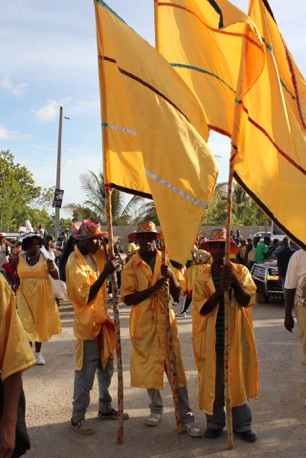
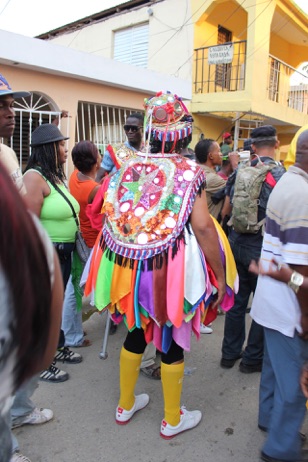
“Majores/Baton major/Majó jon Gaga San Luis, Dominican Republic
“Majores/Baton major/Majó jon Gaga San Luis. The richly beaded Collar and cap is made to seduce and attract the deity to choose the wearer as their “vehicle”.
The flag carriers of Gaga San Luis, Dominican Republic
© Charo Oquet 2014 all rights reserved.
This project is made possible through the generous support of The MAP Fund, a program of Creative Capital, primarily supported by the Doris Duke Charitable Foundation. Additional funds come from The Andrew W. Mellon Foundation. It is also made possible in part by a grant from the the National Performance Network’s Performing America’s Program. Lead funding of the national performance network performing America’s program is provided by the Robert Sterling Clark foundation.
This project is made possible in part by a grant from the National Performance Network’s Performing America’s Program. Lead funding of the national performance network performing America’s program is provided by the Robert Sterling Clark foundation. Sponsored in part by the State of Florida, Department of State, Division of Cultural Affairs, the Florida Arts Council, and the National Endowment for the Arts.